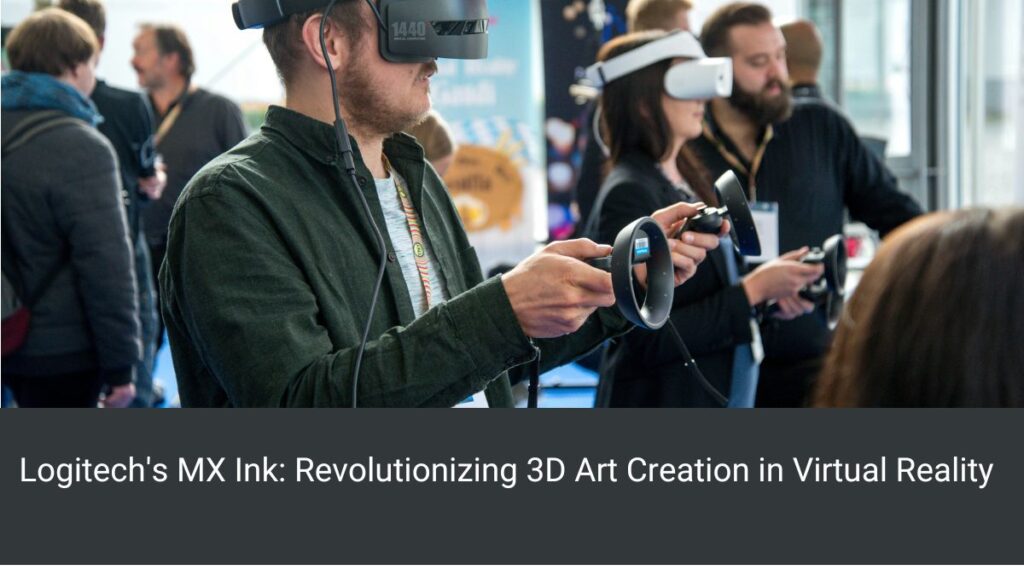A Groundbreaking Stylus for the Quest Ecosystem
In a move that promises to revolutionize the way artists create and sculpt in virtual reality (VR), Logitech has unveiled its latest innovation: the MX Ink, a wireless stylus specifically designed for Meta’s Quest headsets. Set to launch this fall, the $130 peripheral is poised to become the Quest’s first official stylus accessory, coinciding with Meta’s highly anticipated Connect developer conference in late September.
A Fusion of Design and Functionality
At first glance, the MX Ink resembles a chunky black pen, but its sleek exterior belies its cutting-edge capabilities. Adorned with buttons on the sides and boasting a replaceable nib, this stylus transcends the realm of traditional drawing tools. Unlike its predecessors, the MX Ink is fully spatially trackable, enabling unparalleled 6DoF (degrees of freedom) motion, mirroring the precision and fluidity of Meta’s own Quest controllers.
A Personal Perspective: Unleashing Artistic Potential in VR
As an avid enthusiast of virtual reality and a passionate artist, the prospect of a dedicated stylus tailored for the Quest ecosystem fills me with excitement. The ability to sculpt and create in three-dimensional space has long been a tantalizing promise of VR technology, but the limitations of existing input methods have often hindered the full realization of this potential. With the MX Ink, artists like myself can now envision a future where the boundaries between physical and digital art blur, opening up new realms of creative expression.
Elevating the VR Art Experience
One of the standout features of the MX Ink is its integrated haptic feedback system, which simulates the sensation of drawing on various surface materials. This innovative feature promises to enhance the immersive experience of creating art in VR, allowing artists to perceive the nuances of different textures and mediums, just as they would in the physical world.
Moreover, the stylus’ pressure-sensitive tip ensures precise control over strokes and brushwork, further bridging the gap between traditional and digital art forms. This level of precision and tactile feedback is particularly invaluable for 2D artists transitioning to the realm of VR, as it provides a familiar and intuitive interface for their craft.
Seamless Integration and Compatibility
One of the key strengths of the MX Ink lies in its seamless integration with existing Quest applications and workflows. The stylus is designed to work alongside a controller simultaneously, enabling artists to swap between input devices or use them in tandem, further expanding the creative possibilities.
Logitech has ensured that the MX Ink is compatible with a wide range of Quest apps, including industry-renowned software such as Adobe Substance Modeler, Gravity Sketch, PaintingVR, and Arkio, among others. This compatibility not only ensures a smooth transition for artists already familiar with these tools but also opens up new avenues for collaboration and experimentation across various disciplines.
The Future of XR Art and Peripherals
As virtual reality and augmented reality (collectively known as extended reality or XR) continue to evolve, the demand for dedicated peripherals and input devices tailored to these immersive experiences will only continue to grow. With the introduction of the MX Ink, Logitech and Meta have firmly established themselves as pioneers in this burgeoning market, setting the stage for a future where XR art and creation become increasingly accessible and intuitive.
While tech giants like Apple have yet to venture into this space with dedicated XR art peripherals, the success of the MX Ink could potentially catalyze further innovation and competition, ultimately benefiting artists and creators worldwide.
As we stand on the precipice of a new era in digital art and creation, it is essential to recognize the significance of tools like the MX Ink. By empowering artists with intuitive and immersive input methods, we unlock the full potential of virtual reality as a medium for creative expression. The future of XR art promises to be an exhilarating journey, where the boundaries between physical and digital realms dissolve, and the limitless expanse of the virtual world becomes the canvas upon which our wildest artistic visions can take shape.

